Competition in store for Josh Jacobs: Jacobs joins a Green Bay Packers team that also drafted MarShawn Lloyd and retained A.J. Dillon, so this is already more competition than he ever faced during his time with the Las Vegas Raiders.
Jacobs could set a career-high in targets: The departure of Aaron Jones leaves Green Bay without a clear third-down running back. Jacobs may take on this role.
Get a head start on fantasy football: Use PFF's fantasy football mock draft simulator to create real live mock draft simulations to prepare for your live draft!
Estimated reading time: 5 minutes
The PFF player profile series gives the most in-depth view of a player possible. The profiles use the best data points at PFF’s disposal to examine how well the player has performed, what competition the player has for touches and how other teammates and coaches will impact each player's performance.
Last updated: 7:15 a.m. Thursday, July 11
Player Performance
Jacobs has been among the league's best rushers over the last five years. His 92.9 PFF rushing grade since 2019 ranks fourth among running backs, behind only Nick Chubb, Derrick Henry and Tony Pollard. He’s also forced 295 tackles as a runner, which leads all players at the position.
The former first-round pick peaked in 2022 and was the only running back named to the AP All-Pro first team. He wasn’t nearly as effective in 2023, likely due to his unhappiness with the organization.
Outside of his ability to force missed tackles, much of his production has stemmed from the volume he received in the run game — he's produced elite volume stats, while his efficiency stats haven’t been as strong. He has performed particularly well when facing seven or fewer men in the box and particularly poorly when facing eight-man boxes.
Jacobs' receiving numbers haven't been overwhelmingly impressive. He’s typically never played on third-and-long, but he’s run plenty of routes on first and second downs in his career.
However, his target rate has been relatively high, considering his size. Over the last five years, only six 220-plus-pound running backs have a target rate above 19% on 500 or more routes. In comparison, 20 running backs under 220 pounds have a target rate above 19%. Jacobs is one of the six.
One of the biggest problems for Jacobs in both the running and passing game is his inability to break huge plays. He’s scored 46 touchdowns in the NFL, and only five have been for more than 20 yards. His ability to consistently gain some yards but not make big plays has made him a better running back in real life than in fantasy football.
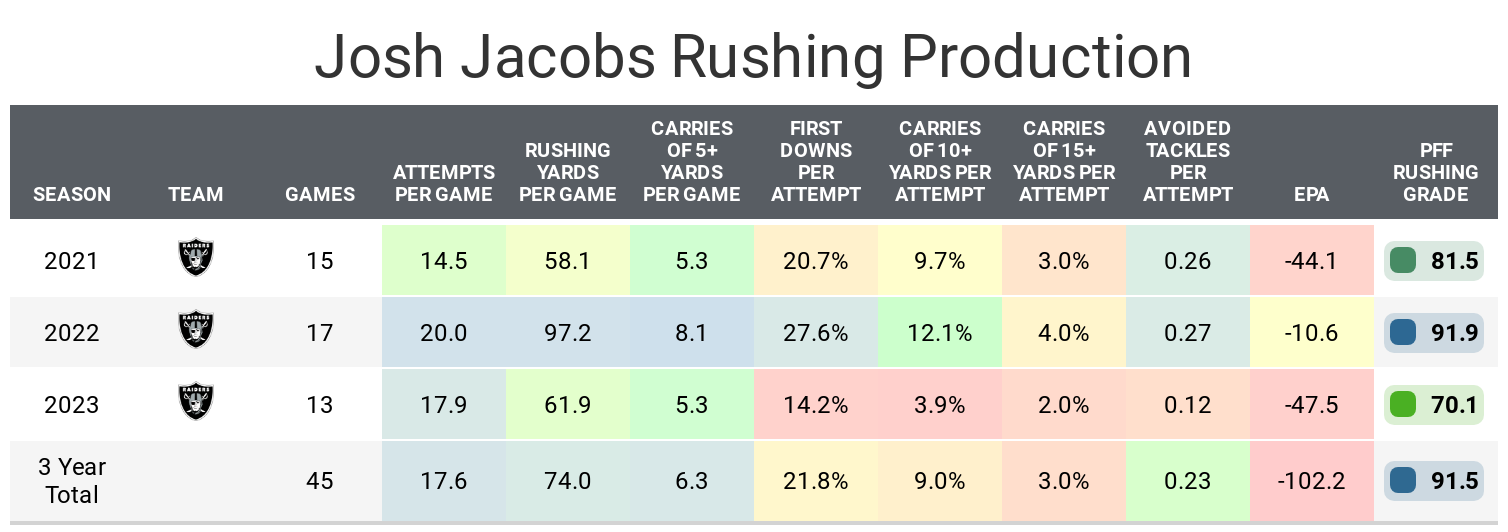
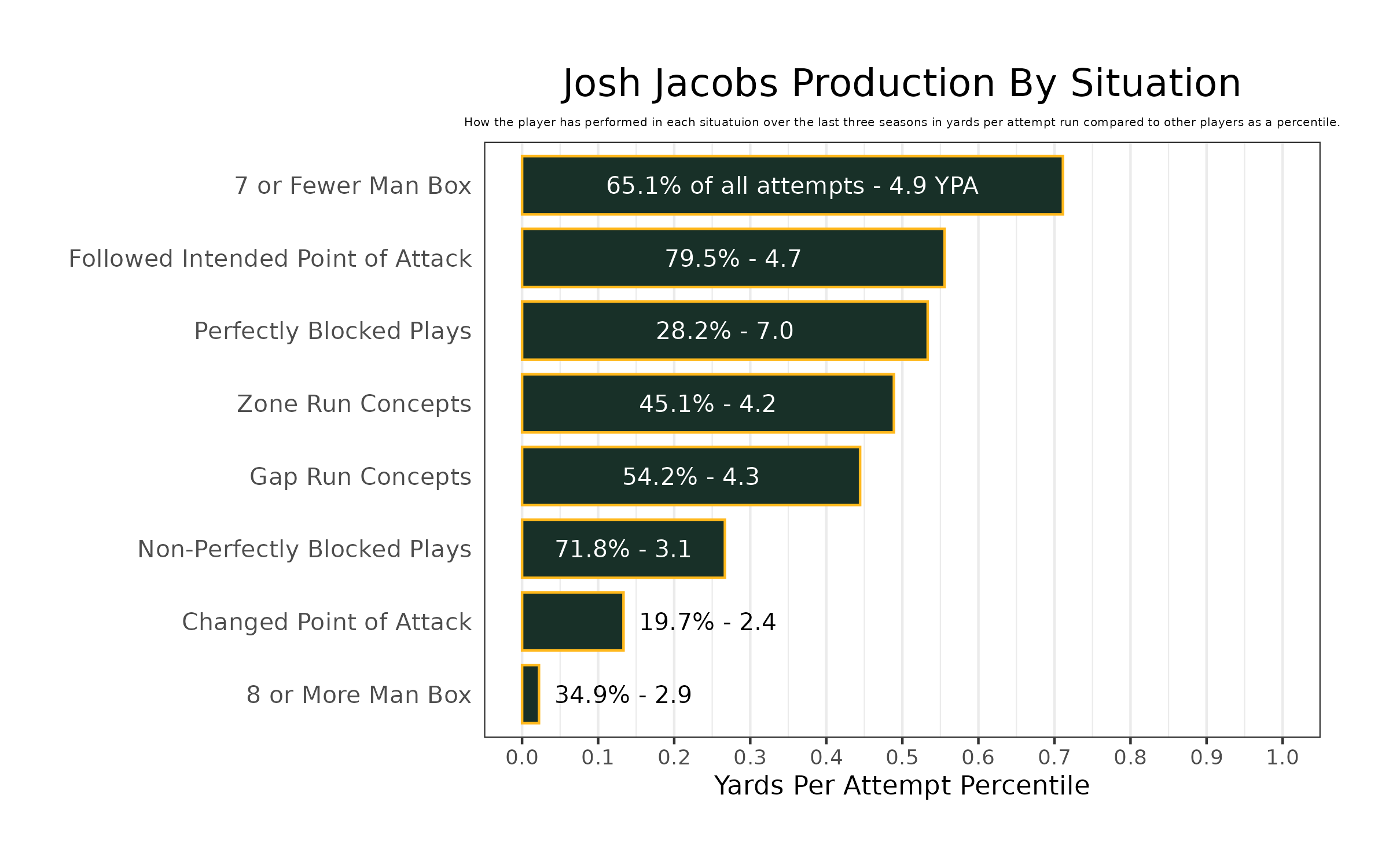
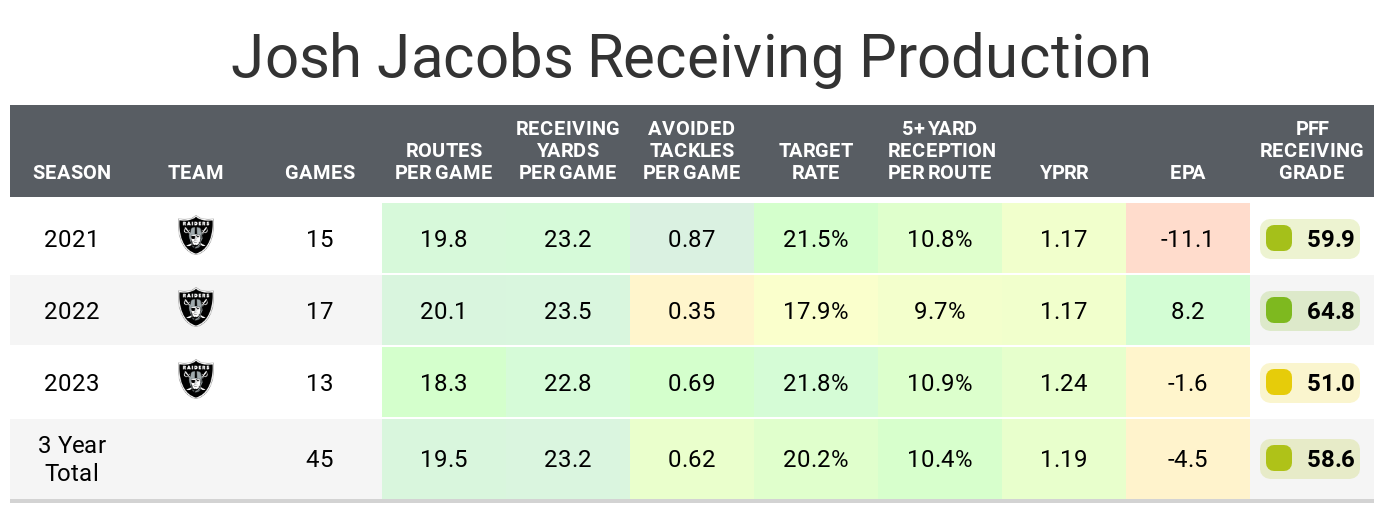
Competition for Touches
Jacobs will face much more competition for touches with the Green Bay Packers than he ever did with the Raiders. He has consistently served as the early-down, goal-line and short-yardage running back at rates most fantasy managers dream of.
In Jacobs' last five years with the Raiders, the only other running backs with over 100 carries were Zamir White and DeAndre Washington. Green Bay has A.J. Dillon, who has held a similar role to Jacobs in the past, and they added MarShawn Lloyd in the third round of the draft. Jacobs has spoken about not having goals and focused more on his health and legacy, which also points to Jacobs getting the ball less often than usual.
On the bright side, Jacobs was given a four-year, $48 million contract, so he’s assured of having a large role in the offense, even if it’s a rotation. The Packers also don’t have a clear third-down back anymore.
Aaron Jones held this role in recent years, but none of the three running backs on the roster have much experience in third-and-long situations. This might point to the Packers using four-receiver sets on third downs or having a tight end in the backfield, as the Cincinnati Bengals started doing last season.
It’s also possible that Jacobs plays fewer snaps on early downs and more on third downs. This could lead to more receptions, which would help his fantasy value in PPR leagues. Plus, Jacobs has had conversations with coach Matt LaFleur about boosting his production as a pass-catcher.
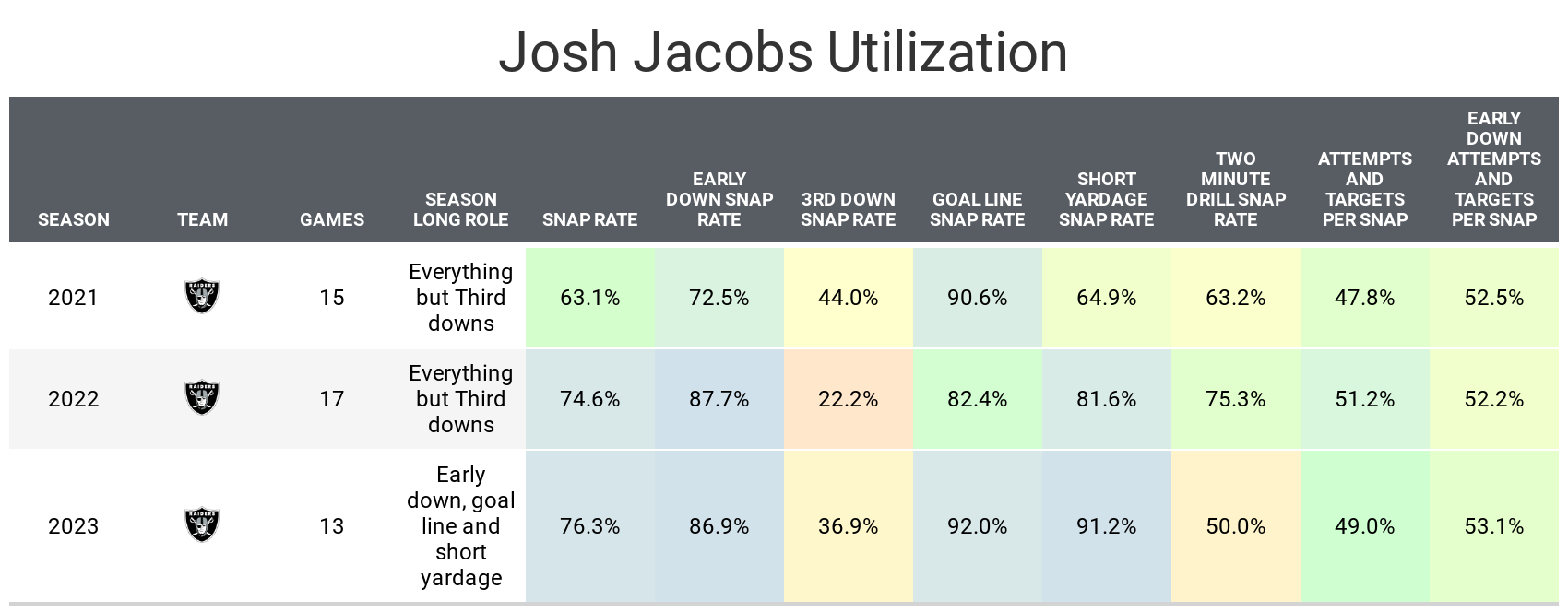

Impact of Teammates
Thr impact of Jacobs the Green Bay Packer might not be as big as many expect. Green Bay has rarely fielded a featured running back. In recent years, it was Aaron Jones and A.J. Dillon. Before that, Jamaal Williams was in the mix. In 2018, when LaFleur was the offensive coordinator of the Tennessee Titans, Dion Lewis recorded 155 carries, limiting Derrick Henry to 215. Given the addition of Lloyd in the draft, it’s pretty clear this will at least be a two-back committee.
The Packers' offensive line isn’t as big a strength as it’s been in the past, with its PFF grade declining in recent seasons. And the group has now lost starter Jon Runyan, top backup Yosh Nijman and often-injured David Bakhtiari this offseason.
Sean Rhyan, who has played only 179 offensive snaps, is penciled in to take the veteran left tackle's place, even though Jordan Morgan was picked in the first round (the Packers generally develop their rookie linemen a little bit before putting them in the lineup).
The Packers have generally prioritized pass protection over run blocking in their linemen. Luckily, most of the line has been better at avoiding mistakes than making great blocks, which tends to suit Jacobs.
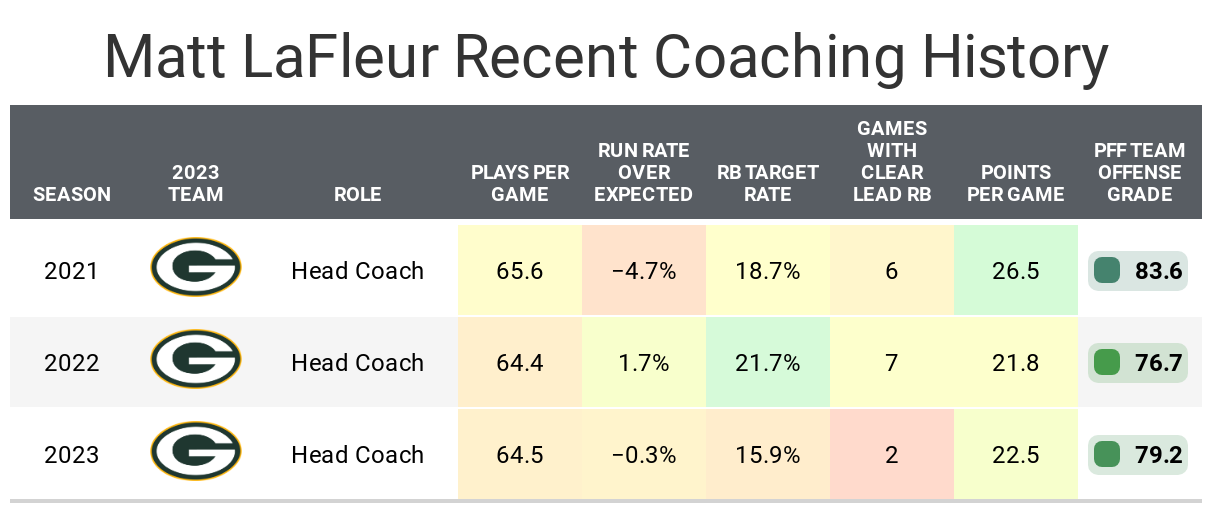
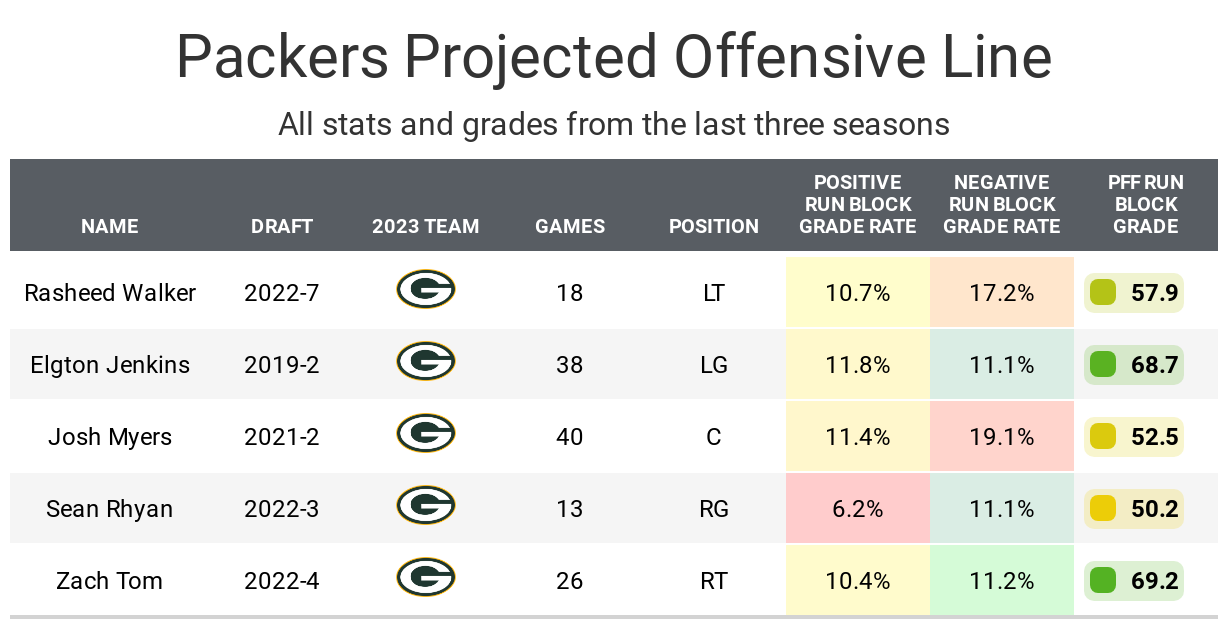
Bottom Line
Josh Jacobs is guaranteed to handle fewer carries per game in Green Bay than he ever did with Las Vegas. However, he should see more targets, and targets are more valuable for fantasy production.
There is still a lot of uncertainty about how running back snaps will get distributed in Green Bay. A top-five season is within the realm of possibilities if he takes the Aaron Jones role and thrives, but it’s also possible that MarShawn Lloyd outshines him and Jacobs is a bust.

Footnotes
-
- The statistics for the tables and charts were generally chosen based on their ability to predict future fantasy performance (on either a per-game or per-occasion basis) or on their ability to describe the player relative to others at the same position.
-
- Opportunities for this purpose are defined by passing dropbacks, rushing attempts and routes run as a receiver.
-
- Numbers are either by season or based on the last three years. For rookies, only college numbers are included. Only NFL numbers are included for non-rookies, even if they played in college in the last three years.
-
- Because college competition is relatively easier than NFL competition, most rookies will likely see a decline in their numbers compared to their previous numbers.
-
- The colors for all tables in this article range from blue (good or high) to red (bad or low).
-
- All percentiles or colors compare the given player to other players with a high sample of opportunities. Generally, it’s one-third of the possible opportunities given the sample. If the player in question doesn’t have enough opportunities, they are still compared, even though a player could look good or bad on that small sample size, which might not be as predictive.
-
- Information on running back utilization classifications and importance can be found here, wide receiver here and tight end here.




 © 2024 PFF - all rights reserved.
© 2024 PFF - all rights reserved.